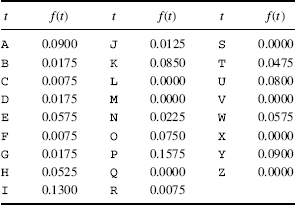7.2 HALF-ROTORS
The RED machine used a half-rotor invented by Swedish cryptographer Arvid G. Damm. Figure 7.1 depicts a half-rotor cipher machine system with keyboard input and lamp output. Twenty-six wires connect pairs of contacts; one on the the rotor's left lateral face (LLF) to one on the rotor's right lateral face (RLF). Although a stationary output contact plate (OCP) is still used to connect the rotor to the output, the input contact plate is replaced by slip rings situated along a shaft attached to the rotor body. Each letter on the (input) keyboard is connected to one of the half-rotor 26 slip rings. The slip rings rotate or slip as the rotor and shaft turn. This mechanical linkage means that each letter is always opposite the corresponding LLF letter in every rotor position.
TABLE 7.1 Japanese Hebern 1-Gram Frequencies

Figure 7.2 shows the encipherment of the same plaintext letter Y by the half-rotor system in two consecutive positions assuming that (1) the rotor's internal wiring connects LLF contact Y to RLF contact D and (2) the RLF contact D is opposite the OCP contact J in the initial position. In the initial rotor position, depressing Y on the keyboard causes a circuit to be completed composed of
- A path from the keyboard Y to the slip ring Y contact;
- A path from the slip ring Y contact to the LLF Y contact;
- A rotor wire from the LLF Y contact to the RLF D contact; ...
Get Computer Security and Cryptography now with the O’Reilly learning platform.
O’Reilly members experience books, live events, courses curated by job role, and more from O’Reilly and nearly 200 top publishers.

